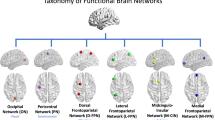Abstract
The assessment of the dynamic status of a network is currently unavailable. It is important to know how far a network is away from its equilibrium (as an indicator of instability) at a moment, and over periods of time. Here, we introduce the Departure from Network Equilibrium (DNE), a new measure of instantaneous network dynamics. DNE is simple, fast to compute, and scalable with network size. We present the results of its application on white noise networks (as a basis) and on networks derived from magnetoencephalographic recordings from the human brain.



















Similar content being viewed by others
References
Bartlett MS (1978) An introduction to stochastic processes with special reference to methods and applications, 3rd edn. Cambridge University Press, Cambridge, MA
Box GEP, Jenkins GM (1970) Time series analysis: forecasting and control. Holden Day, San Francisco, CA
Cherbuin N, Brinkman C (2006) Hemispheric interactions are different in left-handed individuals. Neuropsychology 20:700–707. doi:10.1037/0894-4105.20.6.700
Christopoulos VN, Boeff DV, Evans CD, Crowe DA, Amirikian B, Georgopoulos A, Georgopoulos AP (2012) A network analysis of developing brain cultures. J Neural Eng 9:046008-2560/9/4/046008. doi:10.1088/1741-2560/9/4/046008
Daugman JG (1989) Entropy reduction and decorrelation in visual coding by oriented neural receptive fields. IEEE Trans Biomed Eng 1:107–114
Dimitrov A, Cowan JD (1998) Spatial decorrelation in orientation-selective cortical cells. Neural Comput 10:1779–1795
Doron KW, Bassett DS, Gazzaniga MS (2012) Dynamic network structure of interhemispheric coordination. Proc Natl Acad Sci USA 109:18661–18668. doi:10.1073/pnas.1216402109
Engdahl B et al (2010) Post-traumatic stress disorder: a right temporal lobe syndrome? J Neural Eng 7:066005
Fisher RA (1958) Statistical methods for research workers, 13th edn. Oliver and Boyd, Edinburgh
Fling BW, Peltier SJ, Bo J, Welsh RC, Seidler RD (2011) Age differences in interhemispheric interactions: callosal structure, physiological function, and behavior. Front Neurosci 5:38. doi:10.3389/fnins.2011.00038
Georgopoulos AP, Mahan MY (2013) Simultaneous Departure from Equilibrium (SDE): an efficient measure of dynamic interactions in massively interconnected networks. In: Annual symposium on biomedical informatics and computational biology, Jan 18, Rochester, MN
James LM, Engdahl BE, Leuthold AC, Lewis SM, Van Kampen E, Georgopoulos AP (2013) Neural network modulation by trauma as a marker of resilience: differences between veterans with posttraumatic stress disorder and resilient controls. JAMA Psychiatry 70:410–418
Leuthold AC, Mahan MY, Stanwyck JJ, Georgopoulos A, Georgopoulos AP (2013) The number of cysteine residues per mole in apolipoprotein E affects systematically synchronous neural interactions in women’s healthy brains. Exp Brain Res 226:525–536. doi:10.1007/s00221-013-3464-x
Oldfield RC (1971) The assessment and analysis of handedness: the Edinburgh inventory. Neuropsychologia 9:97–113
Pitkow X, Meister M (2012) Decorrelation and efficient coding by retinal ganglion cells. Nat Neurosci 15:628–635
Rosen BE (1996) Ensemble learning using decorrelated neural networks. Connect Sci 8:373–384
Schwarz GE (1978) Estimating the dimension of a model. Ann Stat 6:461–464. doi:10.1214/aos/1176344136
Vinje WE, Gallant JL (2000) Sparse coding and decorrelation in primary visual cortex during natural vision. Science 287:1273–1276
Acknowledgments
This work was supported by the American Legion Brain Sciences Chair. This material is based upon work partially supported by the National Science Foundation under Grant No. 00006595. Any opinions, findings, and conclusions or recommendations expressed in this material are those of the authors and do not necessarily reflect the views of the National Science Foundation.
Author information
Authors and Affiliations
Corresponding author
Rights and permissions
About this article
Cite this article
Mahan, M.Y., Leuthold, A.C. & Georgopoulos, A.P. Departure from Network Equilibrium (DNE): an efficient and scalable measure of instantaneous network dynamics, with an application to magnetoencephalography. Exp Brain Res 232, 225–236 (2014). https://doi.org/10.1007/s00221-013-3733-8
Received:
Accepted:
Published:
Issue Date:
DOI: https://doi.org/10.1007/s00221-013-3733-8




